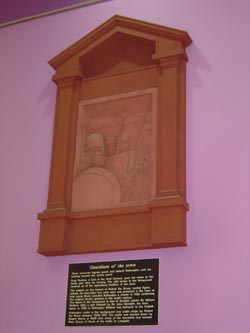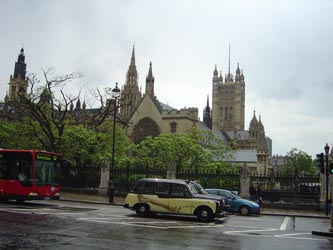SIR WILLIAM WALLACE - A BIOGRAPHY |
|
Blind Harry. Blind Harry was a wandering minstrel in Scotland in the 1400s, and he told tales of William Wallace on his journeying round Scotland. This book is the second biggest selling book ever in Scotland, outsold only by the Bible. This work gives us much detail of Wallace’s early life, but as there is no other source to back any of the tales up, it must be looked at critically from an academic viewpoint. |
 |
From this point on, young men in Scotland, dismayed at the English occupation of their native soil, flock to join Wallace’s banner. |
Little known plaque to William Wallace in the Mitchell Arcade in Rutherglen. It was in Rutherglen that Menteith agreed to betray wallace to the English. |
| to Fortrose Cathedral to be buried. The Scots went on to invade northern England to bring back much needed supplies, and on return from this invasion Wallace was made 'Guardian of Scotland' at the Kirk of the Forest, the remains of which stand in the town of Selkirk. He was also knighted, as from this time on he is referred to as Sir William Wallace. |
The English king, Edward I, commonly known as “Longshanks”, returned from his continental wars, and, gathering another great army, marched north to deal with Wallace. These two armies came face to face at Falkirk in July 1298, and this time the English use of the Welsh longbow was to prove the undoing of the Scots spearmen. The Scots fled, and Wallace resigned the guardianship, preferring to fight the overwhelming might of England with guerrilla tactics. In late 1299, Wallace decided to travel abroad and try to enlist foreign help. He travelled to France, and thence to Rome, hoping that the Pope would exert influence to try and curtail English deprivations in Scotland. |
 |
Looking toward the great window of Westminster Hall, the oldest part of England's Houses of Parliament. It was in this hall that Wallace's sham trial took place. |
He returned to Scotland in 1303, only to find that the English had tightened their grip and that he must start from scratch to try and regain his country's liberty. The fight back began, but the odds were very much stacked against him. Wallace was eventually betrayed and captured at Robroyston near Glasgow, on 3rd August 1305. (A brief historical note: please remember that although the date on the Victorian monument at Robroyston states that the date of Wallace's betrayal and capture was the 5th of August, most Scottish historians agree that in Joseph Stevenson's "Documents Illustrative of Sir William Wallace, His Life and Times" (1841), his capture is given as the eve of Saint Dominic's feast day, which if you Google you will get variously as the 4th, 7th and 8th. The 'Handbook of Dates' that Dr Fiona Watson and most other eminent historians always use is explicit that it is the 4th, so in other words, Wallace was captured on the 3rd August.) He was taken first to Dumbarton Castle, where his sword was left behind, and then he was taken south to London. He arrived in London on the 22nd August. The crowds were so great, so eager to see this Scottish “murderer” that he had to be kept the night in a house in Fenchurch Street. The next morning he was taken to Westminster Hall, the oldest part of the Houses of Parliament, where his sham trial took place. He was allowed no defence, but he managed to shout above his accusers that he was “A Scot, born in Scotland, and did not recognise England as his sovereign nation”. |
| © Society of William Wallace 2007-2026 | The Society of William Wallace is a Scottish Charitable Incorporated Organisation Registration number SC045959 |
